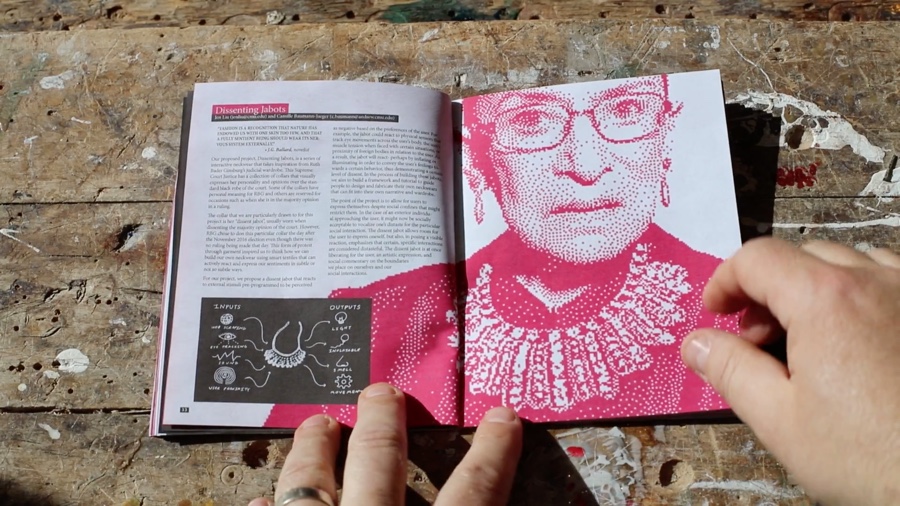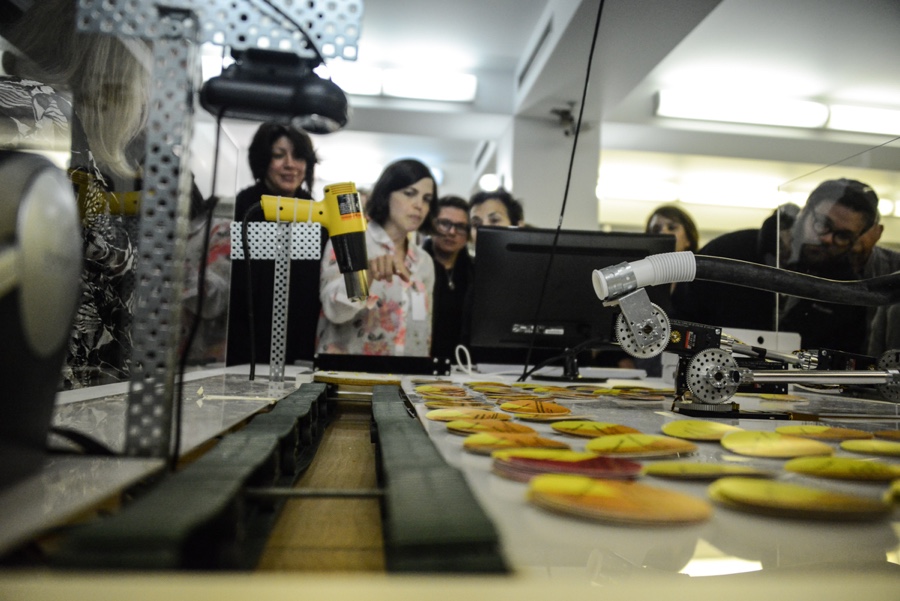I find myself the very lucky and very pleased recipient of the Disobedient Electronics booklet edited and hand-crafted by Garnet Hertz.

Disobedient Electronics. Photo by Garnet Hertz
The booklet’s manifesto calls for more design (or art) that gets out of the sleek graduation shows and galleries, confronts sociopolitical issues head-on and bites back. As he sums up, “Design can be how to punch Nazis in the face, minus the punching.” Hertz isn’t afraid to ruffle a few feathers when he writes in his intro to the publication that:
1. Building electronic objects can be an effective form of social argument or political protest.
2. DIY, maker culture and local artisinal productions can have strong nationalist and protectionist components to them – in some senses, populism can be seen as the rise of the DIY non-expert.
3. Critical and Speculative Design (Dunne & Raby) are worthwhile approaches within industrial design, but perhaps not adversarial enough to reply to contemporary populist right-wing movements (Brexit, Trump & Le Pen). Questions like “Is it moral to punch Nazis in the face?” should be answered with smart alternatives to violence that are provocative pieces of direct action.
4. If we are living in a post-truth time, we should focus on trying to make progressive arguments and facts more legible and engaging to a wide and diverse audience.
5. The fad of ‘Maker Culture’ is over. Arduinos and 3D printers are fascinating things, but the larger issues of what it means to be a human or a society needs to be directly confronted.
A few months ago, Hertz issued a call for submissions and published some of the most inspiring answers he received. Some are works i was familiar with (but always happy to find again in new context and with new texts written by the artists/activists/designers) such as the Abortion Drone by the ever brilliant Women on Waves (& Collaborators), Julian Oliver‘s Transparency Grenade, Román Torre and Ángeles Angulo’s Thero device that allows you to physically manage your data traffic, Eizo Ishikawa and Tamon Sawangdee’s Tamon CRAF, the paperplane machine for protests , I.E.D. (Improvised Empathetic Device) by Matt Kenyon and Doug Easterly, the Barbie Liberation Organization generously offers a Barbie/G.I. Joe home surgery manual, the Institute for Applied Autonomy‘s Robotic Graffiti Writer, etc.

Annina Rüst, A Piece of the Pie Chart. Photo via Unframed
I also discovered some smart ideas and projects that were completely new to me. There’s Annina Rüst’s A Piece of the Pie Chart, a feminist food robot that visualizes the gender gap in art and tech on edible pies. Or The 79% Work Clock that sounds an alarm 79% of the way through the work day to remind us that after a certain time of the day, women stop being paid for their work. Neil MacAloney’s description of Phantom Kitty, a (work in progress) device that would turn on whenever you’re not using the computer, sounds very promising. The tool would perform online searches and open websites, throwing in a vast amount of misinformation into internet tracking activity, rendering data gathering pointless.

Pedro G. C. Oliveira and Xuedi Chen, Backslash (ROUTER. Off-Grid Network)
The works i found most interesting were Pedro G. C. Oliveira and Xuedi Chen’s Backslash, a series of open source functional devices that help activists communicate during a network blackout. I was also very impressed with the Automated Doorbell and Decorative Wreath made by with the Feminist Maker Space at the University of Texas in protest of Campus Carry, a law that provides that license holders may carry a concealed handgun throughout university campuses.

Matt Walker, Device for the Emancipation of the Landscape
There are more projects in the book (all dutifully listed on the webpage of Disobedient Electronics) but i’d like to end with the one i found most touching: Matt Walker’s Device for the Emancipation of the Landscape. This sound-cannon collects sounds from the surrounding landscape through its “mouth.” The field-recordings are then mixed and projected back into urban or industrial sites, opening up the space of authority and offering an opportunity to reflect on both the human impact and treatment of landscape.
Garnet Hertz, Disobedient Electronics: Protest, 2017
I love the booklet: the hand-made format, the colour, the whole impetus behind its creation, most of the works included (or rather i love ALL of the works included, i just felt that some of them were only scratching on the surface and wouldn’t reach anyone beyond the usual art/activist audiences). Disobedient Electronics is a great starting point for a much-needed discussion about how art, design and creative practices in general can challenge issues such as homophobia, sexism, racism, economic inequalities, political status-quo, etc. I think that in general media art and interactive design are far too complacent when it comes to creating socially-engaged works. Too often, the projects are more about getting some attention from bloggers and festival curators and less about directly getting to grips with a specific issue. Or reaching out to the ‘general’ public.
I would love more publications like Disobedient Electronics, with artists from other parts of the world for example. If Hertz makes another issue, i’ll definitely send something.
There are only 300 copies of the booklet available, if you feel you can contribute in any way to the project, Hertz might send you one of the last copies for free…

Disobedient Electronics. Photo by Garnet Hertz

Disobedient Electronics. Photo by Garnet Hertz

Disobedient Electronics. Photo by Garnet Hertz

Disobedient Electronics. Photo by Garnet Hertz
Previously: Critical Making and an Interview with Garnet Hertz.







